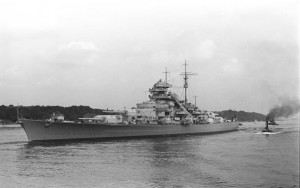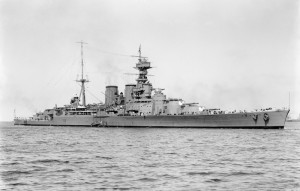
The Bismarck, probably Germany’s most famous battleship in was sunk on May 27th 1941. The Bismarck had sunk HMS HOOD on 24 May before being sunk herself

On May 18th 1941 Bismarck and the heavy cruiser Prinz Eugen slipped out of the Baltic port of Gdynia to attack Allied convoys in the Atlantic. Grand Admiral Raeder intended for the Bismarck, the Prinz Eugen, the Scharnhorst and the Gneisenau to operate in the Atlantic supported by supply and reconnaissance ships. However, Raeder’s plan, code-named “Exercise Rhine”, was severely hampered when the Gneisenau was hit by bombs while in Brest and repairs needed by the Scharnhorst were taking longer than anticipated. Regardless, Raeder ordered the Bismarck and the Prinz Eugen to sail as planned under the command of Admiral Lutjens.
On May 21st, both ships docked at Kors Fjord, near Bergen. Prinz Eugen needed to refuel; when the news reached the Admiralty that the Bismarck and Prinz Eugen had left Bergen, Admiral Sir John Tovey, Commander-in-Chief Home Fleet, ordered HMS HOOD and HMS PRINCE OF WALES to sail, accompanied by six destroyers. The ships left Scapa Flow on May 22nd.
All other ships in Scapa Flow and some on the Clyde were put on short notice. To boost his fleet, Tovey ordered HMS VICTORIOUS to sail on the 22nd May and on the following day the battle cruiser HMS REPULSE sailed. At noon on May 23rd, Bismarck and Prinz Eugen entered the Denmark Strait, between Iceland and Greenland.
At 19.22 on May 23rd, the cruiser HMS SUFFOLK spotted both the Bismarck and the Prinz Eugen in the mist. SUFFOLK reported her sighting and HMS NORFOLK picked this report up. At 20.22, the NORFOLK spotted both German ships. SUFFOLK’S report reached the HOOD and Admiral Holland, on the HOOD concluded that there were 300 miles between his ship and the Bismarck. Holland ordered that the HOOD should steer a course for the exit of the Denmark Strait and the battle cruiser steamed off at 27 knots. At this speed, the ‘Hood’ should come into contact with the ‘Bismarck’ at 06.00 on May 24th. The HMS KING GEORGE V and HMS VICTORIOUS also picked up the message but were both 600 miles away. The Admiralty remained concerned for the safety of the convoys in the Atlantic as there was always the danger that Bismarck might slip away. Therefore, the HMS RENOWN, HMS ARK ROYAL AND HMS SHEFFIELD were ordered to sea from Gibraltar to give further protection to the convoys.
‘Bismarck’ had darkness on her side and for a couple of hours; SUFFOLK and NORFOLK lost touch with the Bismarck. Without their positioning information, HOOD could easily have lost contact with the Bismarck. However, by 02.47 on May 24th, SUFFOLK had regained contact with the Bismarck. At 05.35, the lookout from the HOOD made out the Prinz Eugen and the Bismarck at a distance of 17 miles.
Holland ordered HOOD to turn to the German ships and at 05.45 they were only 22,000 metres apart. At 05.52, HOOD opened fire and shortly afterwards was joined by PRINCE OF WALES. At 05.54, both the Prinz Eugen and the Bismarck fired their guns primarily against HOOD.
The Prinz Eugen hit HOOD and set alight some anti-aircraft shells kept on deck. The fire this caused was not particularly dangerous though it produced a great deal of smoke. At 06.00 a salvo from the Bismarck hit HOOD. The Bismarck had fired from 17,000 metres and the elevation of her guns meant the shells had a high trajectory and steep angle of descent. HOOD had minimal horizontal armour and one of the shells from the Bismarck penetrated HOOD’s deck. A massive explosion tore the ‘Hood’ in half. Only three men of a total crew of 1,419 survived.
After the destruction of HOOD, the Germans turned their fire onto PRINCE OF WALES. Her captain, Leach, turned away under the cover of smoke and, along with SUFFOLD and NORFOLK continue to tail the Bismarck and Prinz Eugen. Bismarck had not escaped untouched, A shell had pierced two oil tanks. The damage was minimal but it meant that 1000 tons of fuel was no longer available to the Bismarck. Lütjens decided to split up the Bismarck and Prinz Eugen, hoping to split up the ships that were pursuing him alone. In this he failed. As the Prinz Eugen steamed away, the pursuers targeted only the Bismarck.
At this point the battleship HMS KING GEORGE V was only 200 miles away and closing fast. Accompanying the KING GEORGE V was the carrier HMS VICTORIOUS. At 22.10 on May 24th nine Swordfish torpedo-bombers left VICTORIOUS to attack the Bismarck. By midnight the planes had found the Bismarck and attacked. Eight torpedoes were launched at the Bismarck and one hit home amidships but did no damage. Nevertheless, Lütjens informed Berlin that it was impossible for him to shake off the Royal Navy and that he was abandoning the task in hand to sail to St Nazaire as his ship was short of fuel.
As the Bismarck sailed, she was tailed by the SUFFOLK, NORFOLK and PRINCE OF WALES. Just after 03.06 on May 25th, the SUFFOLK lost contact with the Bismarck and it was assumed that she was steaming west into the Atlantic. In fact, the Bismarck was doing the opposite – sailing east for a port in Biscay. At 08.00, Swordfish from the VICTORIOUS were sent up to look for the Bismarck but found nothing. NORFOLK and SUFFOLK also drew a blank. What gave away the Bismarck was the Bismarck itself.
Lütjens sent Hitler a message about his contact with the Hood. This message was picked up by the Royal Navy and informed Tovey that the Bismarck was, in fact, making for the Biscay ports. At 18.10 KING GEORGE V and other ships turned to the Biscay ports Bismarck had a lead on them of 110 miles. The weather also favoured the Bismarck as it was deteriorating and visibility was reduced as the cloud as low. The Admiralty used Catalina flying boats to search for the Bismarck. On May 27th, the Catalina’s finally spotted the Bismarck.
This information was given to the Swordfish crews from HMS ARK ROYAL which was steaming up from Gibraltar. They took off at 14.30 in rapidly deteriorating weather. The lead Swordfish spotted a large ship on its radar and fourteen planes dived through cloud for an attack. Unfortunately, they attacked HMS SHEFFIELD as they were unaware that she was in the same area shadowing the Bismarck. Luckily no damage was done to the ‘Sheffield’.
The Swordfish returned to VICTORIOUS to be re-fuelled and re-armed. By 19.10, they were airborne once again. At 19.40 they spotted SHEFFIELD, which gave the crews the direction of the ‘Bismarck’ -12 miles to the south-east. Fifteen planes attacked the ‘Bismarck’ and there were two definite torpedo hits and one probable. One of the torpedoes damaged Bismarck’s starboard propeller, wrecking her steering gear and jamming her rudders. Two observation planes saw the ‘Bismarck’ literally sailing in circles in the immediate aftermath of the attack and at less than 8 knots. The attack had crippled the ‘Bismarck’. Throughout the night the stricken battleship was harassed by destroyers under the command of Captain Vian.
The destroyers shadowed the ‘Bismarck’ and fed her position back to the NORFOLK. NORFOLK was joined by the battleships ‘RODNEY and KING GEORGE V. On May 27th at 08.47, RODNEY opened fire on the ‘Bismarck’. At 08.48, KING GEORGE V did the same. ‘Bismarck’ fired back but a salvo from RODNEY took out the two forward gun turrets of the ‘Bismarck’. By 10.00 all her main guns had been silenced and her mast had been blown away. By 10.10, all her secondary armaments had been destroyed and the giant ship simply wallowed in the water. At 10.15, Tovey called off his battleships and ordered HMS DORSETSHIRE to sink the ‘Bismarck’ with torpedoes. Three torpedoes were fired at the ‘Bismarck’ and she sank at 10.40. Out of her crew of 2,200, there were only 115 survivors. Only 2 officers out of 100 survived.
For more about this eventful week there are many books to be read. A selection can be found here: The Sinking of the Bismarck


